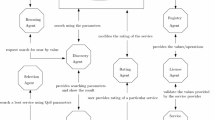Abstract
Knowledge and competence management in companies focus on resources allocation to business activities, knowledge management approaches promise a positive impact on cost structures. Moreover, with cloud computing and multi-agent systems, we can have a positive impact on business process construction. In fact, cloud computing gives us the ability to perceive resources such as unlimited computer resources. Meanwhile, multi-agent systems provide some degree of independence to achieve specific goals. Nowadays, on the web we can find a significant number of services that provide the same functionality. Hence, business process construction by reusing these services has become a challenging problem. The solution proposed in this paper, can be considerate as an enterprise solution to construct a business process using some competence and knowledge management aspects. Furthermore, the solution is based on cloud computing and agents to discover similar services and classify services according to their similarity degrees and their quality of services.















Similar content being viewed by others
References
Charif, Y., Stathis, K., & Mili, H. (2010). Towards anticipatory service composition in ambient intelligence. New Technologies of Distributed Systems (NOTERE), 49–56.
Cherifi, C., Labatut, V., & Santucci, J.-F. (2010). Benefits of semantics on web service composition from a complex network perspective. Networked Digital Technologies, 80–90.
Coria, J. A., Castellanos-Garzón, J. A., & Corchado, J. M. (2014). Intelligent business processes composition based on multi-agent systems. Expert Systems with Applications, 41(4), 1189–1205.
Dalkir, K. (2013). Knowledge management in theory and practice. Routledge.
Dumas, M., Garcia-Banuelos, L., & Dijkman, R. M. (2009). Similarity search of business process models. IEEE Data Engineering Bulletin, 32(3), 23–28.
Fox, A., Griffith, R., Joseph, A., Katz, R., Konwinski, A., Lee, G., . . . Stoica, I. (2009). Above the clouds: a Berkeley view of cloud computing. Dept. Electrical Eng. and Comput. Sciences, University of California, Berkeley, Rep. UCB/EECS, 28, 13.
Garcia, V.C., Lucredio, D., Alvaro, A., De Almeida, E.S., de Mattos Fortes, R.P., & de Lemos Meira, S.R. (2007). Towards a maturity model for a reuse incremental adoption. SBCARS (pp. 61–74).
García, J. M., Ruiz, D., & Ruiz-Cortés, A. (2012). Improving semantic Web services discovery using SPARQLBased repository filtering. Web Semantics: Science, Services and Agents on the World Wide Web, 17, 12–24.
Guan, Y., Ghose, A. K., & Lu, Z. (2006). Using constraint hierarchies to support QoS-guided service composition. Web Services, 2006. ICWS ‘06. International Conference on (ICWS) (pp. 743–752).
Hyunyoung, K., Seog-Chan, O., Ergin, E., Wonhong, N., & Dongwon, L. (2009). Graph theoretic topological analysis of web service networks. World Wide Web, 12(3), 321–343.
Jun, Y., Ryszard, K., Jian, L., Mohan, B. C., Suk, K. G., & Jianying, Z. (2007). Autonomous service level agreement negotiation for service composition provision. Future Generation Computer Systems, 23(6), 748–759.
Katakis, I., Meditskos, G., Tsoumakas, G., Bassiliades, N., & Vlahavas, I. (2009). On the combination of textual and semantic descriptions for automated semantic web service classification. Artificial Intelligence Applications and Innovations III, 296, 95–104.
Keller, U., Lara, R., Lausen, H., Polleres, A., & Fensel, D. (2005). Automatic location of web services. ESWC (pp. 1–16).
Küster, U., & König-Ries, B. (2008). Evaluating semantic web service matchmaking effectiveness based on graded relevance. The 7th International Semantic Web Conference, 35.
Lacheheub, M. N., & Maamri, R. (2015). Intelligent business process based cloud services. New Contributions in Information Systems and Technologies, 83–92. doi:10.1007/978-3-319-16528-8_9
Mell, P., & Grance, T. (2009). Draft NIST working definition of cloud computing. Referenced on June. 3rd, 15, 32.
Mili, H., Tremblay, G., Jaoude, G. B., Lefebvre, E., Elabed, L., & Boussaidi, G. E. (2010). Business process modeling languages: sorting through the alphabet soup. ACM Computing Surveys (CSUR), 43(1), 4.
Miller, M. (2008). Cloud computing: Web-based applications that change the way you work and collaborate online. Que Publishing.
Oberweis, A. (1996). An integrated approach for the specification of processes and related complex structured objects in business applications. Decision Support Systems, 17(1), 31–53.
Paolucci, M., Kawamura, T., Payne, T. R., & Sycara, K. (2002). Semantic matching of web services capabilities. International Semantic Web Conference (ISWC) (pp. 333–347).
Rehesaar, H. (2011). Capability assessment for introducing component reuse. Top Productivity through Software Reuse (6727), 87–101.
Richard, E., & Boyatzis. (1982). The competent manager: a model for effective performance. Wiley.
Rifkin, K. I., Fineman, M., & Ruhnke, C. H. (1999). Developing technical managers--first you need a competency model. Research Technology Management, 42(2), 53.
Schuler, R. S., Jackson, S. E., & Luo, Y. (2004). Managing human resources in cross-border alliances. London: Routledge.
Siala, F., Lajmi, S., & Ghedira, K. (2011, December). Multi-agent selection of multiple composite web services based on CBR method and driven by QoS. Proceedings of the 13th International Conference on Information Integration and Web-based Applications and Services (pp. 90–97).
Su, Z., Chen, H., Zhu, L., & Zeng, Y. (2012). Framework of semantic web service discovery based on fuzzy logic and multi-phase matching. Journal of Information and Computational Science, 9(1), 203–214.
Supyuenyong, V., & Islam, N. (2006). Knowledge management architecture: building blocks and their relationships. (IEEE) Technology Management for the Global Future, 2006. PICMET 2006, 3, 1210–1219.
Sycara, K., Paolucci, M., Ankolekar, A., & Srinivasan, N. (2003). Automated discovery: interaction and composition of semantic web services. Web Semantics: Science, Services and Agents on the World Wide Web, 1(1), 27–46.
Talia, D. (2011). Cloud computing and software agents: towards cloud intelligent services. WOA, 11, 2–6.
Zakaria, M., Soraya, K. M., & Hamdi, Y. (2005). Toward an agent-based and context-oriented approach for web services composition - appendices. IEEE Trans. Knowl. Data. Eng.
Ziqiang, X., Martin, P., Powley, W., & Zulkernine, F. (2007). Reputation-enhanced QoS-based web service discovery. IEEE International Conference on Web Services, 2007. ICWS 2007 (pp. 249–256).
Author information
Authors and Affiliations
Corresponding author
Rights and permissions
About this article
Cite this article
Lacheheub, M.N., Maamri, R. Towards a construction of an intelligent business process based on cloud services and driven by degree of similarity and QoS. Inf Syst Front 18, 1085–1102 (2016). https://doi.org/10.1007/s10796-016-9625-2
Published:
Issue Date:
DOI: https://doi.org/10.1007/s10796-016-9625-2




